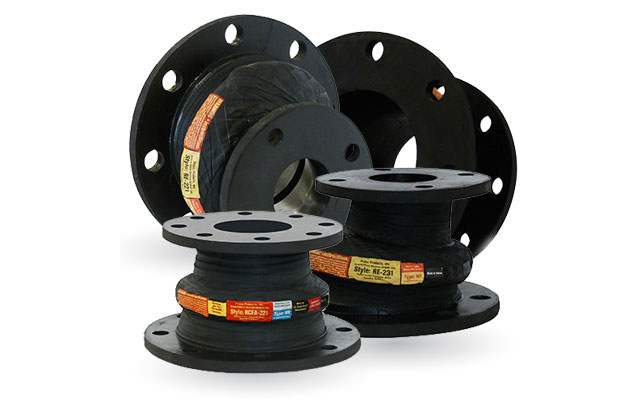Author: Cal Hayes, General Manager, WaterWorks Division, Proco Products Inc.
Expansion joints can be found in most fluid pumping systems. They are commonly installed in the piping network near a pump or valve and provide value by isolating rotating equipment from thermal growth. When pipes grow, expansion joints compensate for thermal growth in the pipe system. This helps to prevent stress from being transferred to a pump or piece of rotating equipment. When a pump becomes stressed as a result of thermal growth, there is risk of bearing problems and mechanical seal failure. Expansion joints, depending on their composition and design, may also help to reduce system vibration and noise. With so many expansion joints available to the market, it can be a challenge to find the right one for your application. Below are some considerations to help as you shop for expansion joints.
Use the acronym STAMP.
S – Size of the ID (inside diameter) and overall length
T – Temperature (system temperature)
A – Application. Where will the expansion joint be located in the system?
M – Material. What is the material being conveyed? Is it water? Chemicals? Solids?
P – Pressure. Are you dealing with positive, vacuum, or surge pressures?
In addition to knowing how quickly you need the expansion joint (delivery time is always a very important factor when shopping for expansion joints), you must also know the end drilling pattern. Is it a 150 lb. drill? A 300 lb. drill? Metric drilling? How is that expansion joint going to be bolted to the system? What method? You must have answers to these questions when you begin searching for expansion joints. Keep in mind that a rubber expansion joints needs to be installed against a flat face flange, if that is not available, a spacer ring gasket should be used.
Keep in mind that fluid piping expansion joints can be made from a range of materials, including rubber, metal, Teflon and convoluted PTFE. So how do you know which to use in your system?
Choosing the right expansion joint requires a complete understanding of your system’s temperature, pressure, and fluid composition. Rubber expansion joints made from standard elastomers can withstand temperatures up to 250-degrees Fahrenheit; while expansion joints made from convoluted PTFE are manufactured to handle temperatures up to 400 degrees F. Convoluted PTFE has a temperature/pressure relationship; so the higher the temperature, the lower the capability. If you are pumping fluid that is highly acidic or caustic, an expansion joint made from convoluted PTFE is going to perform better in your application that pumps fluids having very high PH. When you have a combination of high pressure and high temperatures, a metal bellows would be a better solution for your pumping system. Higher temperatures may need to be supplied with a Viton elastomer which can be supplied up to 400 degrees Fahrenheit.
Work with a Vendor You Trust.
This goes without saying, right? There are a few things to look out for when you are researching expansion joint manufacturers. First, make sure you can talk to a real person. If you call an expansion joint manufacturer and you cannot reach a real person over the phone, then consider contacting a different vendor. Knowing you can speak with a person over the phone can provide real assurance that someone will be there when you need them most. Next, confirm that the expansion joint manufacturer you are evaluating has inventory on-hand for immediate delivery. Keep in mind that if your requirements are out of the ordinary, then the manufacturer will most likely have to manufacture, thus extending the delivery. When people need parts, they typically need them fast. If the manufacturer is maintaining on-site delivery, you have the added confidence of knowing you can get your expansion joints quickly. Lastly, check out the manufacturers’ experience. How long have they worked in the pump industry? Do they have field experience? Do they concentrate in only a few markets? Are they involved with any leading industry organizations? Don’t be afraid to ask lots of questions. You want to make sure you’re working with people who really know what they’re talking about.
Don’t just replace, IMPROVE.
If you are replacing expansion joints frequently, it is possible you have an underlying issue that needs to be resolved. If you rule out system issues and determine you need a different expansion joint, there are alternatives to improve the life of your expansion joints. The key to installing an expansion joint that works well for a long time is to select the right one for your system. In order to do this, make sure to provide in-depth system data to the expansion joint manufacturer so they can thoroughly understand the application. Proco Products, for example, uses a Rubber Expansion Joint Specification Form so we can help owners obtain the right expansion joint for their pipe system.
It is always a good idea to take pictures of your existing expansion joints in operation as well as the surrounding area where the expansion joint is installed so a qualified vendor can help you diagnose the root cause of your problem and help you choose an expansion joint that will work best in your system.
Take Advantage of Proco’s Tool Box
Review our Elastomer Guide to compare properties of common elastomers.
Use our Chemical Guide to see elastomer chemical resistance tables.
Check out the Interchange Guide to Identify and Convert Your
Expansion Joint Requirement.
If you have any questions about expansion joints, contact sales@procoproducts.com.





Comments